In Search of Auxin
It has long been known that stems bend toward the light; and one might infer that a plant bends toward the light because it needs light. But how does it do this?While working with germinating grass seedlings, Charles Darwin (famous for his theory of evolution) observed that the stem bent toward the light when the tips were exposed, and that curvature did not take place if the tips of the seedlings were shielded from light.
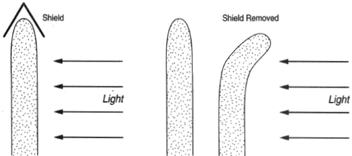 |
| Figure 29-1 When the growing tip is shielded from light, no bending occurs. When the shield is removed, bending takes place |
Figure 29-1 shows only the tip being shielded from light, and the curvature itself occurring a short distance below the tip. The name for this phenomenon is heliotropism (helio meaning “sun”), and, as Darwin observed, curvature occurs even when light is extremely dim.
If germinating grass seedlings are covered with a vial painted black and a slight scratch is made in the paint, the seedlings will curve toward the slight amount of light able to enter through the scratch. Likewise, if a tin can having a pin hole is placed over several seedlings and a light is placed outside the tin can, the seedlings will curve toward the pinhole.
Years after Darwin made his observations, Peter Boysen-Jensen performed experiments on oat seedlings. He observed that when he cut off the oat seedlings' tips and subsequently exposed the seedlings to light, no curvature took place. When he put the tip back on again, however, curvature did occur.
Boysen-Jensen performed another experiment that demonstrated that something produced in the tip of the seedling moved down to have an effect a short distance below the tip. First, he cut the tip off the seedling, placed a thin wedge of gelatin on the cut surface, and replaced the tip on top of the gelatin. In this case, curvature did occur. Next, he performed the same steps but substituted a piece of mica for the gelatin. In this case, no curvature occurred. It seemed, then, that the gelatin allowed some diffusible substance to pass through, while the mica instead acted as an obstruction.
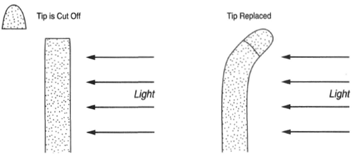 |
| Figure 29-2 When the growing tip is cut off, no curvature takes place. If the tip is then replaced, curvature will again occur. |
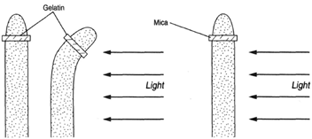 |
| Figure 29-3 At left, when a thin wedge of gelatin is placed between the tip and the region of curvature, curvature occurs. At right, when a thin piece of mica is substituted for the gelatin, no curvature occurs. |
Another interesting thing was observed by Arpad Pad in Hungary. When he cut off the tip and then replaced it off center, curvature occurred without light being involved
It was thus learned that a diffusible substance called auxin is produced in the growing tip and diffuses to the cells below. Here, it acts as a cell-wall softener, allowing elongation of the cells. This substance is apparently inactivated by light such that the concentration of it is greater on the side away from the light. Note that when a cell stretches more on one side than on the other, it curves. Thus, the uneven distribution of auxin, the substance being greater on the side away from the light, causes the stem tip to turn toward the light. Auxin, then, fits the definition of a plant hormone
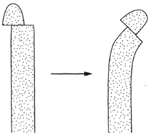 |
| Figure 29-4 When the growing tip is replaced off center, auxin will diffuse into the cells on the left and allows curvature. |
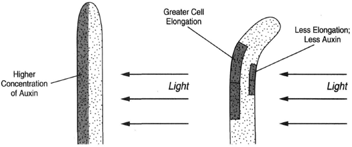 |
| Figure 29-5 Curvature is explained by the elongation of cells on the side opposite the light. |
If a stem is placed in a horizontal position for a time, it will turn upward. This is not because the plant needs light. Rather, the auxin is apparently pulled down by gravity. Having a higher concentration of auxin on the lower side, the cells on this side elongate, thereby causing the stem to turn upward.
If a root is placed in a horizontal position, just the opposite response takes place-that is, the root curves downward. Although this seems inconsistent with the preceding discussion, there is an explanation. Auxin is pulled to the lower side of the root just as it is in stems. But root cells are sensitive to a lower concentration of auxin. The higher concentration of auxin on the lower side of a root thus has a toxic effect, inhibiting cell elongation. The cells therefore stretch more on the upper side.
 |
| Figure 29-6 A stem tip placed horizontally will curve upwards. |
 |
| Figure 29-7 A root tip placed horizontally will curve downwards. |
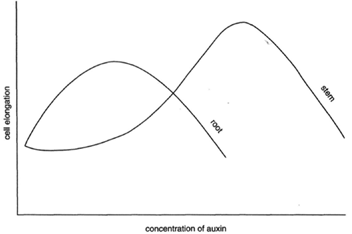 |
| Figure 29-8 The sensitivity of root cells to auxin is far greater than that of stem cells. |
It should be evident, then, that light, rather than being a promoter of growth, has a destructive influence; more growth takes place on the unlighted side, resulting in curvature toward the light.
In 1928 Fritz Went isolated auxin. E Kogl determined its molecular structure: indole acetic acid, or IAA. As shown in figure 29-9, the molecular structure of IAA is remarkably similar to that of the amino acid tryptophane. It is therefore likely that tryptophane is the precursor of IAA.
The degree of bending can be used as a method of measuring IAA concentration. Using a living organism to detect the presence of something is called bioassay. It has been shown that curvature occurs in response to an extremely small concentration of IAA. An amount as small as eight hundredmillionths of a milligram (8 X 10 " mg) will, in fact, cause curvature.
Uses for Auxins
Upon learning the molecular structure of IAA, chemists set about to manufacture related compounds in an effort to determine what biological effects such related compounds might have. One of these compounds is the widely used commercial preparation indole butyric acid.
When such substances are used at a certain concentration, they act as growth promoters; when used at a higher concentration, however, they kill plants. In this respect, then, auxins can be used as weed lullers, as is 2-4 dichlorophenoxyacetic acid (2-4-D). This compound is used as a weed killer on lawns. Used at a certain concentration, it can kill broad-leaved weeds without harming grass.
 |
| Figure 29-9 Indole acetic acid (IAA), at left, is closely related to the amino acid tryptophane, at right. |
 |
| Figure 29-10 Indole butyric acid |
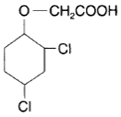 |
| Figure 29-11 2-4 dichlorophenoxyacetic acid. |
How auxins are used and in what concentrations depends on the presenting problem. If an apple tree has too many apples and the fruits are thus unable to develop to full size, for example, a particular auxin at a given concentration can be used to induce some of the fruits to be cast off. If the apples instead tend to drop prematurely, a different concentration of the same auxin can be used to induce retention of the fruits.
Pollination and fertilization are generally necessary for fruits to develop. In certain circumstances, such as the absence of bees, for example, auxins can be used to encourage fruit development without pollination. This is a way that seedless fruits are produced.
Obtaining Auxins
Auxins can be extracted from the medium used in the culture of mushrooms. Auxin for use in experimental work can be obtained by germinating a large number of oat seedlings, cutting off their tips, and extracting the auxin. There is, however, an easier way. Not only is the medium used in the culture of mushrooms a convenient source, but so is urine. Urine actually contains larger quantities of this growth-promoting substance than do plants.




